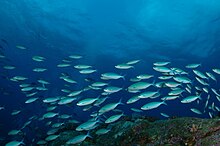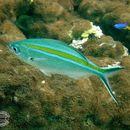Diagnostic Description
provided by Fishbase
This species is distinguished by the following characters: postmaxillary process single; A III,12 (rarely 13); lateral line scales 57-65 (usually around 61); scale rows on spinous part of dorsal fin horizontal; supratemporal bands of scales often interrupted at dorsal midline by a scaleless zone, always a V-shaped scaleless zone anteriorly at midline intruding between the supratemporal band of scales; body colour with upper body bluish and the lower white to pale bluish; a single yellow or golden stripe directly above lateral line except on caudal peduncle where it is about 1 scale above lateral line, the yellow stripe 2 or 3 scales wide, bordered directly above and below by a white or light blue stripe which is about 1 scale wide, caudal-fin lobes with a black median streak (Ref. 68703).Description: Body moderately deep, fusiform, elongate, and moderately compressed. Ratio of eye diameter to head length usually around 3.4-4.2; D X,15 (rarely 14 or 16); pectoral fins with 20 to 22 (rarely 19); scale rows above lateral line to origin of dorsal fin 7-10 (most frequently 9); scale rows below lateral line to origin of anal fin usually 15-18; predorsal scales 20-26; dorsal and anal fins scaled; greatest body depth 2.2-3.1 in SL, head length 2.7-3.4 in SL (Ref. 68703, 90102).
- Recorder
- Estelita Emily Capuli
Life Cycle
provided by Fishbase
Mating behavior is marked by six distinguishable patterns, namely: 1) nuzzling; 2) several males joining in courtship; 3) spiraling towards the surface; 4) pair spawning; 5) sperm release by sneakers; and 6) post spawning.Nuzzling is done about 1-1.5 hours before spawning. For most of the day the fish swam slowly in school. At nearly spawning time, one or two males approach a selected female and begin pecking and pushing her swollen abdomen with their snouts. Interruption happens at this stage resulting in spawners returning to the school. With less than an hour until spawning, 2-6 males may attempt to get their abdomen as close to the female's abdomen as possible. For the pair that completes this position, a spiraling ascent to the surface occurs followed by a release of both eggs and sperm while other males come in pursuit. These sneakers release sperm at the same spot where the initial pair had released their gametes. Some spawnings may occur without sneakers getting involved in the process (Ref. 37498).
Morphology
provided by Fishbase
Dorsal spines (total): 10; Dorsal soft rays (total): 14 - 16; Analspines: 3; Analsoft rays: 10 - 12
- Recorder
- Estelita Emily Capuli
Trophic Strategy
provided by Fishbase
Schools together with C. varilineata, C. striata, and Pterecaesio tile (Ref. 402).
- Recorder
- Estelita Emily Capuli
Biology
provided by Fishbase
Adults are found in schools in deep lagoons and along seaward reefs in coastal areas (Ref. 9710), mixing with other species of fusiliers (Ref. 48636). Juveniles are used as tuna bait fish. They are oviparous, with small pelagic eggs (Ref. 402).
Importance
provided by Fishbase
fisheries: commercial; bait: occasionally
分布
provided by The Fish Database of Taiwan
分布於印度-西太平洋之熱帶海域,西起非洲東岸、紅海,東至薩摩亞,北至日本,南迄新加勒多尼亞。台灣各地岩礁或珊湖礁海域均有產,是常見之種。
利用
provided by The Fish Database of Taiwan
一般以圍網、流刺網或一支釣捕獲。肉質不錯,是市場常見之食用魚,以煎食或紅燒食之。
描述
provided by The Fish Database of Taiwan
體呈長紡錘形;標準體長約為體高之2.9-3.4倍。口小,端位;上頜骨具有伸縮性,且多少被眶前骨所掩蓋;前上頜骨具一個指狀突起;上下頜前方具一帶狀細齒。鰓蓋後緣具一枚小鈍棘,前鰓蓋無鋸齒。體被中小型櫛鱗;頭背前鱗左右不相連而留下一窄的裸露區域;側線完全且近於平直,側線鱗數65-70。背鰭硬棘X,軟條15;臀鰭硬棘III,軟條12;胸鰭鰭條20-22。體背藍色,腹面銀白或淡或帶紅色光澤。體側具一條金黃色縱帶。胸鰭基部具黑色斑塊;尾鰭上下葉各具一條黑色縱帶。本種魚分類上仍有歧見,現依據
Nelson(1994)將其置於笛鯛(Lutjanidae)科中的烏尾鮗亞科(Caesioninae)。
棲地
provided by The Fish Database of Taiwan
主要棲息於沿岸較深的瀉湖或礁石區陡坡外圍海域,性喜大群洄游於中層水域,游泳速度快且時間持久。屬日行性魚類,晝間在水層間覓食浮游動物,夜間則於礁體間具有遮蔽性的地方休息。
Caesio caerulaurea
provided by wikipedia EN
Caesio caerulaurea, the blue and gold fusilier, blue fusilier, gold-band fusilier or scissor-tailed fusilier, is a species of marine fish in the family Caesionidae. It is widespread throughout the tropical waters of the Indo-Pacific area, including the Red Sea.
Taxonomy
Caesio caerulaurea was first formally described in 1801 by the French naturalist Bernard Germain de Lacépède with the type locality given as Molucca in Indonesia.[3] Lacépède used the name Caesio caerulaureus, although this was later corrected to C. caetulaurea as Caesio is feminine, creating a new genus. In 1876 the Dutch ichthyologist Pieter Bleeker designated C. caerulaurea as the type species of the genus Caesio.[4] The specific name caerluaurea is a derived from caeruleaus meaning "sky blue" and aureus which means "golden", a reference to the blue back and yellow flank stripe Lacépède described.[5]
Description
Caesio caeruaurea has a quite deep, fusiform, elongated body which shows moderate lateral compression. There are small conical teeth in the jaws as well as on the vomer and the palatine.[6] The dorsal fin has 10 spines and 14-16 soft rays while the anal fin contains 3 spines and 10-12 soft rays.[2] The dorsal and anal fins have scales.[6] This species attains a maximum total length of 35 cm (14 in), although 25 cm (9.8 in) is more typical.[2] The overall colour of this fusilier is bluish fusilier changing to white on the underside. There is a yellow or golden stripe over the lateral line bordered on both sides by a thin white to pale blue stripe which continues as blackish streaks on both lobes of the forked caudal fin, creating the appearance of scissors.[7]
Distribution and habitat
Caesio caerulaurea has a wide distribution in the tropical waters of the Indo-Pacific. It is found along the eastern coast of Africa from the Red Sea as far south as South Africa then east along through the Indian Ocean, although it is absent from the Persian Gulf into the Pacific. In the Pacific Ocean their range extends east as far as French Polynesia, northwards to southern Japan and south as far as Vanuatu and New Caledonia.[1] In Australia it is found from Shark Bay in Western Australia north to Cassini Island, the Ashmore Reef in the Timor Sea and from the northern Great Barrier Reef off, Queensland south to Sydney. It also occurs at Christmas Island and Lord Howe Island.[7] It occurs at depths between 2 and 40 m (6 ft 7 in and 131 ft 3 in).[1] This species occurs on coastal, lagoon and seaward reefs, typically where there is a healthy growth of corals.[7]
Biology

Caesio caerulaurea (Lacepède, 1801)
Caesio caerulaurea forms large schools in midwater where they feed on zooplankton. They attain sexual maturity quite early, have a high fecundity with numerous small pelagic eggs. Spawning takes place during most of the year, and occurs as mass spawning on lunar cycles.[1]
Spawning behaviour
Caesio caerulaurea has a definite pattern of courtship with six distinct patterns. Firstly as the dusk approaches 1-2 males approach a female and start to nip and butt her abdomen, which is swollen. This takes place 60-90 minutes ahead of spawning. The fish then interrupt this behaviour and return to their shoals. Less than 60 minutes prior to actual spawning 2-6 males will compete to get their abdomen as close to the female’s as they can. Once a male has excluded the other males the pair swim upwards in a spiral to the surface where the eggs and milt are released. This is followed by other “sneaker” males who release their own milt at the spot where the original pair spawned. Sometimes a pair can avoid being followed by “sneaker” males.[2]
Fisheries
Caesio caerulaurea is an important quarry for coastal fisheries, and is frequently recorded in fish markets in Indonesia and the Philippines. They are caught using drive-in nets, gill nets, fish traps, trawls and handlines. The juveniles eniles are used as tuna baitfish in some areas. It is normally caught as part of a multispecies catches of fusiliers. There is also illegal fishing of this species using blasts from explosives thrown in the sea.
References
-
^ a b c d Fricke, R. (2010). "Caesio caerulaurea". IUCN Red List of Threatened Species. 2010: e.T155097A4703967. doi:10.2305/IUCN.UK.2010-4.RLTS.T155097A4703967.en. Retrieved 20 November 2021.
-
^ a b c d Froese, Rainer; Pauly, Daniel (eds.) (2021). "Caesio caerulaurea" in FishBase. February 2021 version.
-
^ Eschmeyer, William N.; Fricke, Ron & van der Laan, Richard (eds.). "Species in the genus Caesio". Catalog of Fishes. California Academy of Sciences. Retrieved 2 July 2021.
-
^ Eschmeyer, William N.; Fricke, Ron & van der Laan, Richard (eds.). "Genera in the family Lutjanidae". Catalog of Fishes. California Academy of Sciences. Retrieved 2 July 2021.
-
^ Christopher Scharpf & Kenneth J. Lazara, eds. (5 January 2021). "Order LUTJANIFORMES: Families HAEMULIDAE and LUTJANIDAE". The ETYFish Project Fish Name Etymology Database. Christopher Scharpf and Kenneth J. Lazara. Retrieved 3 July 2021.
-
^ a b K.E. Carpenter (2001). "Caesionidae". In Carpenter, K.E. & Volker H. Neim (eds.). The Living Marine Resources of the Western Central Pacific Volume 5: Bony fishes part 3 (Menidae to Pomacentridae) (PDF). FAO Species Identification Guide for Fishery Purposes. FAO Rome. p. 2926.
-
^ a b c Bray, D.J & Thompson, A.S. (2020). "Caesio caerulaurea". Fishes of Australia. Museums Victoria. Retrieved 2 July 2021.

- license
- cc-by-sa-3.0
- copyright
- Wikipedia authors and editors
Caesio caerulaurea: Brief Summary
provided by wikipedia EN
Caesio caerulaurea, the blue and gold fusilier, blue fusilier, gold-band fusilier or scissor-tailed fusilier, is a species of marine fish in the family Caesionidae. It is widespread throughout the tropical waters of the Indo-Pacific area, including the Red Sea.
- license
- cc-by-sa-3.0
- copyright
- Wikipedia authors and editors
Description
provided by World Register of Marine Species
Inhabits coastal areas, primarily around coral reefs.
Froese, R. & D. Pauly (Editors). (2023). FishBase. World Wide Web electronic publication. version (02/2023).
- license
- cc-by-4.0
- copyright
- WoRMS Editorial Board

